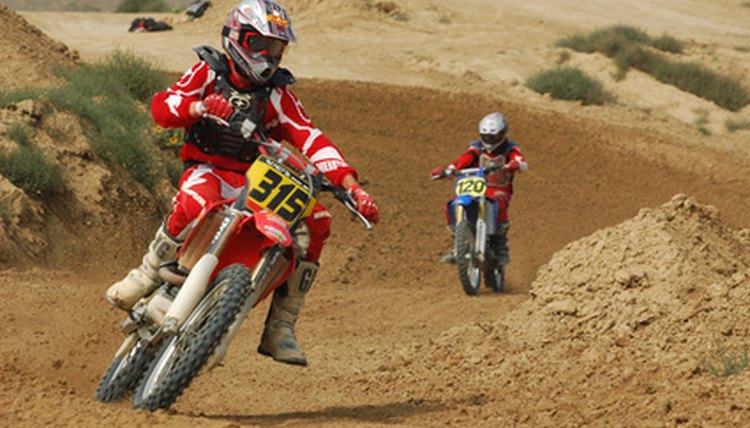Parts of a Dirt Bike

Dirt bikes are motorcycles specifically designed for use on dirt, sand and muddy, gravelly terrain. They differ from regular motorcycles in that their tires and ground clearance are optimized to dirt riding instead of pavement. They are lighter than regular motorcycles, without fairings or plush extras, to boost speed and power performance on trails, and have no extra creature comforts such as soft seats or passenger backrests.
Chassis
When stripped down, motorcycles have a basic frame with suspension attached. The frame is the structural support for the bike, made from steel or aluminium, and carries the weight of everything else attached. The bike's suspension, important in a rough-riding dirt bike, has two parts. The rear shocks, under the rider, attach to the rear axle via the swing arm. The swing arm is the part of the bike that attaches horizontally to the rear axle. Front suspension is by means of the front forks. These stretch from the front of the bike, on either side of the instrument panel, down to the front axle and are usually adjustable in dirt bikes for compression and rebound.
Wheels
Dirt bikes have special tires to cope with bad terrain. Tires specifically designed for hard terrain have soft rubber with closely spaced tread blocks. Soft terrain tires have a scoop or paddle-type tread block pattern made of hard rubber. Sand tires have a widely spaced, paddle tread for the best grip. Intermediate soft/hard tires are also available with characteristics in between the soft and hard types.
Engine
Dirt bikes are commonly classed into engine displacement categories. The displacement of an engine is that volume of air and fuel which is drawn in in a single cycle and is measured in cubic centimeters, or cc's. Dirt bikes usually include their cc in their name for easy identification; for example, the BMW G450X and the Beta 450 RS Supermoto are different brands but share the same displacement. The cylinder configuration of a motorcycle--V-twin or in-line-four--alters engine performance capability. The central area of the bike houses the engine, the oil reservoir for lubrication, the transmission (where gears are engaged manually or automatically) and the fuel tank.
Brakes
Dirt bikes need good brakes to handle the trials of motocross and trail riding. Each wheel has separate brakes. These can be drum brakes, where the stopping pressure is applied from the inside of the axle; or disc brakes, where a pad is applied to the outside of the brake to slow the bike.
Final Drive
Dirt bike final drive systems can be chain, belt or shaft driven. The chain or shaft allows power to be transmitted from the gearbox to the wheels to move the bike. The drive runs from the gearbox back to the rear axle.
Writer Bio
Jillian O'Keeffe has been a freelance writer since 2009. Her work appears in regional Irish newspapers including "The Connacht Tribune" and the "Sentinel." O'Keeffe has a Master of Arts in journalism from the National University of Ireland, Galway and a Bachelor of Science in microbiology from University College Cork.
